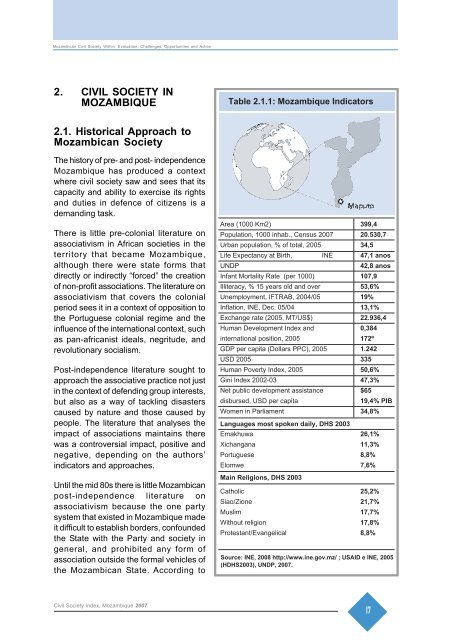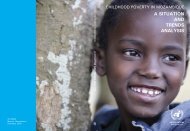Mozambican Civil Society Within: - UNICEF Mozambique - Home page
Mozambican Civil Society Within: - UNICEF Mozambique - Home page
Mozambican Civil Society Within: - UNICEF Mozambique - Home page
You also want an ePaper? Increase the reach of your titles
YUMPU automatically turns print PDFs into web optimized ePapers that Google loves.
<strong>Mozambican</strong> <strong>Civil</strong> <strong>Society</strong> <strong>Within</strong>: Evaluation, Challenges, Opportunities and Action<br />
2. CIVIL SOCIETY IN<br />
MOZAMBIQUE<br />
Table 2.1.1: <strong>Mozambique</strong> Indicators<br />
2.1. Historical Approach to<br />
<strong>Mozambican</strong> <strong>Society</strong><br />
The history of pre- and post- independence<br />
<strong>Mozambique</strong> has produced a context<br />
where civil society saw and sees that its<br />
capacity and ability to exercise its rights<br />
and duties in defence of citizens is a<br />
demanding task.<br />
There is little pre-colonial literature on<br />
associativism in African societies in the<br />
territory that became <strong>Mozambique</strong>,<br />
although there were state forms that<br />
directly or indirectly “forced” the creation<br />
of non-profit associations. The literature on<br />
associativism that covers the colonial<br />
period sees it in a context of opposition to<br />
the Portuguese colonial regime and the<br />
influence of the international context, such<br />
as pan-africanist ideals, negritude, and<br />
revolutionary socialism.<br />
Post-independence literature sought to<br />
approach the associative practice not just<br />
in the context of defending group interests,<br />
but also as a way of tackling disasters<br />
caused by nature and those caused by<br />
people. The literature that analyses the<br />
impact of associations maintains there<br />
was a controversial impact, positive and<br />
negative, depending on the authors’<br />
indicators and approaches.<br />
Until the mid 80s there is little <strong>Mozambican</strong><br />
post-independence literature on<br />
associativism because the one party<br />
system that existed in <strong>Mozambique</strong> made<br />
it difficult to establish borders, confounded<br />
the State with the Party and society in<br />
general, and prohibited any form of<br />
association outside the formal vehicles of<br />
the <strong>Mozambican</strong> State. According to<br />
Area (1000 Km2)<br />
Population, 1000 inhab., Census 2007<br />
Urban population, % of total, 2005<br />
Life Expectancy at Birth,<br />
UNDP<br />
Infant Mortality Rate (per 1000)<br />
Illiteracy, % 15 years old and over<br />
Unemployment, IFTRAB, 2004/05<br />
Inflation, INE, Dec. 05/04<br />
Exchange rate (2005, MT/US$)<br />
Human Development Index and<br />
international position, 2005<br />
GDP per capita (Dollars PPC), 2005<br />
USD 2005<br />
Human Poverty Index, 2005<br />
Gini Index 2002-03<br />
Net public development assistance<br />
disbursed, USD per capita<br />
Women in Parliament<br />
INE<br />
Languages most spoken daily, DHS 2003<br />
Emakhuwa<br />
Xichangana<br />
Portuguese<br />
Elomwe<br />
Main Religions, DHS 2003<br />
Catholic<br />
Siao/Zione<br />
Muslim<br />
Without religion<br />
Protestant/Evangelical<br />
399,4<br />
20.530,7<br />
34,5<br />
47,1 anos<br />
42,8 anos<br />
107,9<br />
53,6%<br />
19%<br />
13,1%<br />
22.936,4<br />
0,384<br />
172º<br />
1.242<br />
335<br />
50,6%<br />
47,3%<br />
$65<br />
19,4% PIB<br />
34,8%<br />
26,1%<br />
11,3%<br />
8,8%<br />
7,6%<br />
25,2%<br />
21,7%<br />
17,7%<br />
17,8%<br />
8,8%<br />
Source: INE, 2008 http://www.ine.gov.mz/ ; USAID e INE, 2005<br />
(HDHS2003), UNDP, 2007.<br />
<strong>Civil</strong> <strong>Society</strong> Index, <strong>Mozambique</strong> 2007<br />
17
















